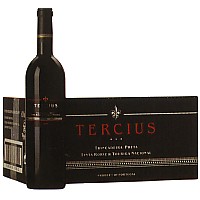Getting a little (just a little) nationalistic with the Touriga Nacional
In Portugal, my money's on Ribatejo. This is a central region of the country, not far to the northwest of the Alentejo. It's traditionally a bulk wine producer since the area nearest the banks of the Tagus River feature alluvial soil that spawns cheap quaffable reds. Now that stonier vineyards higher up in the Ribatejo have been discovered, cultivated and exploited by modern vintners, some serious wine (and serious wine grapes like Cabernet and Syrah) are now on the scene. One outfit making a name for itself in the rocky upper vineyards around Almeirim is Falua, maker of Tercius 2000. This is another blend that does not present overwhelming tannin (though it is aged in small oak barrels). To me, the 2000 vintage leads with a whole lot of savoury fruit. It is composed of three different grape varieties, hence the name on the label.
One outfit making a name for itself in the rocky upper vineyards around Almeirim is Falua, maker of Tercius 2000. This is another blend that does not present overwhelming tannin (though it is aged in small oak barrels). To me, the 2000 vintage leads with a whole lot of savoury fruit. It is composed of three different grape varieties, hence the name on the label.
Trincadeira Preta, which is known for deep colour, great richness and fruity aromas, also goes by the name Tinta Amarela, Espadeiro and Castelão. Tinta Roriz is Tempranillo, as already mentioned earlier this week, another spicy and flavourful grape. So where -- and I've been wondering this all week -- does the generalization that all Portuguese wine is tannic and acidic come from? Perhaps that lies with the Touriga Nacional, finally making a star appearance for Portuguese week, four bottles into the week and the third grape to round out this blend's threesome.
Touriga Nacional, more than any of the other regional grapes, is known for its tannins. It seems to me that most of the other varieties I've been tasting are really not all that tannic. It may be a coincidence, but I've also only been drinking the less expensive wines -- ones that you would be not expect to be age-worthy and therefore likely to contain the tannic Touriga. I would imagine that the more you go up in price, the more the wine features a grape that raises the ageability factor: the quest for structure, if you will, is not selling cheap. And so -- me of little wallet -- I am guessing that Touriga is not selling cheap either.
I think that most of the Portuguese wine people are buying, like my purchases, are actually blends composed mainly Tinto Roriz. And this is good. I think it should help demystify the rustic reputation of Portugal as well as all this acid and tannin business.
But onto the Tercius 2000. Having no more than a fraction of Touriga Nacional, this wine ages only to a certain extent. I'm not sure why the 2000 is still on store shelves instead of a more recent vintage. Don't bother decanting this. I think six years is its limit. Tannins are present but supple and yielding. Notes of wood also bind the wine together and create a nice structure.
This reminds me a lot of a Languedoc wine. There's dark fruit leading to a licorice centre. Pervasive notes of pork fat counterbalanced by a herbal astringency. The nose is slightly bitter but on the palate there's a smoothness that's very reminiscent of Port wine. And like the Trincadeira Preta would have you believe, this wine is entirely and deeply purple in colour.
Almeirim, Portugal. 13.5%.







No comments:
Post a Comment